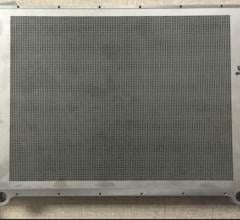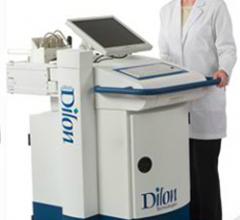If you enjoy this content, please share it with a colleague
Dilon Technologies
RELATED CONTENT
Preliminary tests have demonstrated that a new device may enable up to six times better contrast of tumors in the breast, while maintaining the same or better image quality and halving the radiation dose to patients.
ECRI Institute released a report listing three key questions and the answers concerning breast-specific gamma imaging (BSGI; sometimes referred to as molecular breast imaging or MBI). The technology uses a specially designed gamma camera system to image the uptake of a tracer that emits gamma radiation (most commonly 99mtechnetium-sestamibi [MIBI]). MIBI is preferentially taken up by cancer tissue, and thus BSGI can be used to image breast cancer for a variety of clinical indications. Unlike X-ray mammography, BSGI is not affected by the density of breast tissue, and therefore it may be particularly useful for screening and diagnosis of breast cancer in women with dense breast tissue.
Molecular Breast Imaging (MBI), also known as Breast-Specific Gamma Imaging (BSGI), is a procedure that is able to detect breast cancers missed by mammography and ultrasound, particularly in women with dense breasts. The MBI procedure is now available in hundreds of breast centers nationwide and is commonly utilized as a tool along with mammography and ultrasound to help in the diagnosis of breast cancer. Although the radiation dose associated with this procedure is already low enough to be used in select cases, new research is being conducted to find ways to reduce the dose further so that MBI may be used in annual breast cancer screening for high-risk women with dense breast tissue. The latest results from this research were presented at the Chicago International Breast Course in October by Marcela Bohm-Velez, M.D., the principal investigator of an ongoing trial at Weinstein Imaging Associates in Pittsburgh, Pa.
According to a new market research report "Breast Imaging Technologies Market (Digital Mammography,3D Breast Tomosynthesis, Breast MRI, Breast Ultrasound, Molecular Breast Imaging, Optical Imaging, PET/CT/PEM Modalities) Technology and Market Analysis & Global Forecasts to 2017" is an attempt to showcase the market impact of current and emerging breast imaging technologies having excellent growth potential in the coming five years. The technologies profiled in the report are segmented into Ionizing breast imaging modalities and Non-Ionizing breast imaging technologies on basis of radiation. Ionizing breast imaging modalities include Mammography, 3D Breast Tomosynthesis, Cone beam Computed Tomography (CBCT), Positron Emission Mammography (PEM), Molecular Breast Imaging (MBI), Positron Emission Tomography (PET) and Breast Specific Gamma Imaging (BSGI). The various Non-ionizing modalities for breast screening covered in the report are Breast MRI, Optical Imaging, Breast thermography and Breast Ultrasound.
July 16, 2012 — According to a new study by Korean researchers at the Ewha Women's Hospital in Seoul, published this year in the Annals of Nuclear Medicine, molecular breast imaging (MBI), also known as BSGI, may be a better choice than magnetic resonance imaging (MRI) for women who have a new cancer diagnosis and dense breast tissue detected by mammography.
May 9, 2012 — Two studies presented at the Society of Surgical Oncology 2012 Annual Cancer Symposium found that the SurgicEye declipseSPECT may improve the accuracy of non-imaging gamma probes by providing 3-D images of the tumor and lymph nodes.
February 28, 2012 — According to a new study published in the American Journal of Roentgenology (AJR) in January 2012, molecular breast imaging (MBI), also known as breast-specific gamma imaging (BSGI), can detect cancers missed by the two most common breast imaging studies, mammography and ultrasound. BSGI had the highest overall sensitivity (91 percent) for breast cancer detection, significantly higher than that of mammography and ultrasound, 74 and 84 percent respectively.
December 13, 2011 – Molecular breast imaging (MBI) has been found to be equivalent to magnetic resonance imaging (MRI) as an adjunct imaging modality in the diagnosis of breast cancer. MBI may be especially useful for the evaluation of high-risk women or those with dense breasts.
December 13, 2011 – According to a new study, molecular breast imaging (MBI), can provide critical information in the initial diagnostic workup and surgical planning for patients with newly diagnosed breast cancer. Adding MBI to conventional imaging, namely mammography and ultrasound, enhances pre-surgical planning.
August 30, 2011 — Dilon Diagnostics announced it has added several PenRad products to its portfolio of women’s imaging technology, including the PenRad Mammography Information System (MIS) and Volpara, a quantitative breast density assessment tool.


 June 21, 2016
June 21, 2016 






